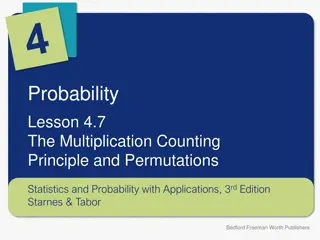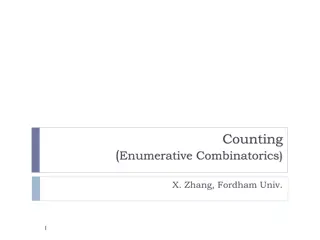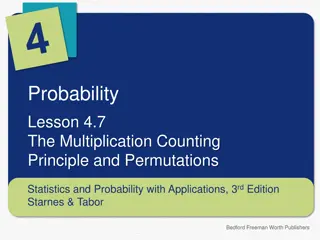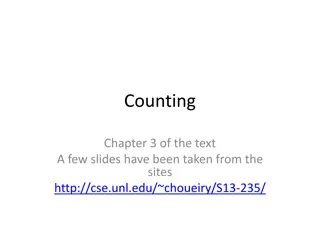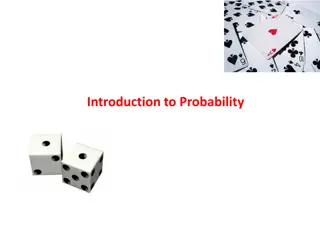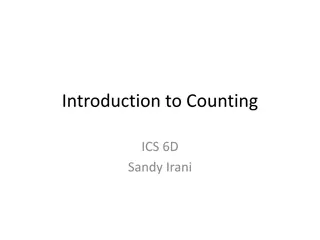Understanding Counting Rules and Probability in Mathematics
The content delves into fundamental counting rules such as the Fundamental Counting Rule, Permutation Rule, and Combination Rule to help determine the number of possible outcomes for sequences of events. Factorial notation and permutations are also explained, along with examples to illustrate their applications in real-life scenarios. By applying these mathematical concepts, one can calculate probabilities in various situations, like drawing specific cards from a deck.
Download Presentation

Please find below an Image/Link to download the presentation.
The content on the website is provided AS IS for your information and personal use only. It may not be sold, licensed, or shared on other websites without obtaining consent from the author. Download presentation by click this link. If you encounter any issues during the download, it is possible that the publisher has removed the file from their server.
E N D
Presentation Transcript
DO NOW If fours cards are drawn from a deck without replacement, find the probability of getting these results: All kings All diamonds All sevens
COUNTING RULES Many times, we must know how many possible outcomes there are for a sequence of events. 1. Fundamental Counting Rule 2. Permutation Rule 3. Combination Rule
THE FUNDAMENTAL COUNTING RULE In a sequence of n events in which the first one has k1possibilities and the second one has k2 possibilities, and the third has k3, and so forth, the total number of possibilities of the sequence will be k1 k2 k3 kn
THE FUNDAMENTAL COUNTING RULE Example A paint manufacturer wishes to manufacture several different paints. The categories include: Color: red, blue, white, black, green, brown, yellow Type: Latex, oil Texture: flat, semigloss, high gloss Use: outdoor, indoor How many different kinds of paint can be made if you can select one color, one type, one texture, and one use?
THE FUNDAMENTAL COUNTING RULE More examples: A coin is tossed and a die is rolled. Find the number of outcomes for the sequence of events. The manager of a department store chain wishes to make 4-digit ID cards for her employees. How many different cards can be made if she uses the digits 1, 2, 3, 4, 5, and 6 and repetitions are permitted? What if repetitions were not permitted?
FACTORIAL NOTATION These rules use factorial notation the exclamation point 5! = 5 4 3 2 1 Factorial Formula: For any counting n, n! = n(n-1)(n-2)(n-3) 1
PERMUTATIONS A permutation is an arrangement of n objects in a specific order. Example Suppose a business owner has a choice of 5 locations in which to establish her business. She decides to rank each location according to certain criteria, such as price of store and parking facilities. How many different way can she rank the 5 locations?
PERMUTATIONS Permutation Rule: The arrangement of n objects in a specific order using r objects at a time is called a permutation of n objects taking r objects at a time. It is written nPr and the formula is nPr= n ! (n-r)!
PERMUTATIONS Examples 1. A school musical director can select 2 musical plays to present next year one in the fall and one in the spring. If she has 9 to pick from, how many different possibilities are there? A television news director wishes to use 3 news stories on an evening show. One story will be the lead story, one will be the second story, and the last will be a closing story. If the director has a total of 8 stories to choose from, how many possible ways can the program be set up? 2.
COMBINATIONS A selection of distinct objects without regard to order is called a combination. Example: Suppose a dress designer wishes to select two colors of material to design a new dress, and she has on hand four colors. How many different possibilities can there be in this situation? ***This is different from permutations because order does not matter.
COMBINATIONS Combination Rule: The number of combinations of r objects selected from n objects is denoted nCrand the formula is: nCr= n ! (n-r)! r!
COMBINATIONS Examples: 1. A newspaper editor has received 8 books to review. He decides that he can use 3 reviews in his newspaper. How many different ways can these 3 reviews be selected? 2. In a club there are 7 women and 5 men. A committee of 3 women and 2 men is to be chosen. How many different possibilities are there?
PERMUTATION VS. COMBINATION Given the letters A, B, C, and D, list the permutations and combinations for selecting two letters.
SKILLS CHECK Garage door openers originally had a series of four on/off switches so that homeowners could personalize the frequencies that opened their garage doors. If all garage door openers were set at the same frequency, anyone with a garage door opener could open anyone else s garage door. 1. Use a tree diagram to show how many different positions 4 consecutive on/off switches could be in.
SKILLS CHECK After garage door openers became more popular, another set of 4 on/off switches was added to the systems 1. Find a pattern of how many different positions are possible with the addition of each on/off switch. 2. How many different positions are possible with 8 consecutive on/off switches? 3. Is it reasonable to assume, if you owned a garage door opener with 8 switches, that someone could use his or her garage door opener to open your garage by trying all the different possible positions?
SKILLS CHECK In 1989 it was reported that the ignition keys for 1988 Dodge Caravans were made from a single blank that had five cuts on it. Each cut was made at one out of five possible levels. In 1988, assume there were 420,000 Dodge Caravans sold in the US. 1. How many different possible keys can be made from the same key blank? 2. How many different 1988 Dodge Caravans could any one key start?
DO NOW How many different ways can 4 tickets be selected from 50 tickets if each ticket wins a different prize? The FBI is trying to crack a suspect s 4 digit cell phone pass code. How many different combinations are possible? There are 22 threatened species of reptiles in the United states. In how many ways can you choose 4 to write about?
PROBABILITY AND COUNTING RULES PART 2 By using the fundamental counting rule, permutation rule, and combination rule, you can compute the probability of outcomes of many experiments, such as getting a full house when 5 cards are dealt or selecting a committee of 3 women and 2 men from a club consisting of 10 women and 10 men.
EXAMPLES 1. Find the probability of getting 4 aces when 5 cards are drawn from an ordinary deck of cards. 2. A box contains 24 transistors, 4 of which are defective. If 4 are sold at random, find the following probabilities: Exactly 2 are defective None is defective All are defective At least one is defective
EXAMPLES A store has 6 Tv Graphic magazines and 8 Newsletter magazines on the counter. If two customers purchased a magazine, find the probability that one of each magazine was purchased. A combination lock consists of the 26 letters of the alphabet. If a 3-letter combination is needed, find the probability that the combination will consist of the letters ABC in that order. The same letter can be used more than once.
EXAMPLE There are 8 married couples in a tennis club. If 1 man and 1 woman are selected at random to plan the summer tournament, find the probability that they are married to each other.
EXIT TICKET- SKILLS CHECK Assume you are given a 5-question multiple-choice quiz. Each question has 5 possible answers: A, B, C, D, and E. 1. How many questions are there? 2. Are the events independent or dependent? 3. If you guess at each question, what is the probability that you get all of them correct? 4. What is the probability that a person would guess answer A for each question?
SKILLS CHECK Assume that you are given a test in which you are to match the correct answers in the right column with the questions in the left column. You can use each answer only once. 1. How many events are there? 2. Are the events independent or dependent? 3. What is the probability of getting them all correct if you are guessing? What is the difference between the two problems?







